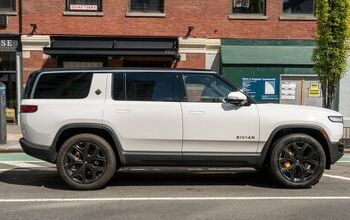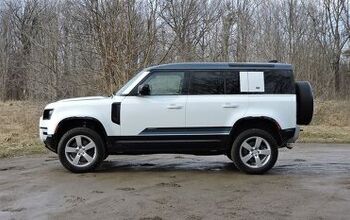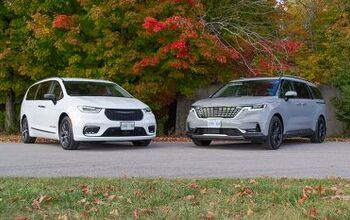2017 Honda CR-V Review

As far as crossovers go, it doesn’t get much more quintessential than the Honda CR-V.
It hit the market all the way back in 1997, long before the term “crossover” was even in vogue, and has quietly dominated ever since, selling at a torrid pace only the Toyota RAV4 has been able to match. There’s never been anything sexy about the CR-V, but that hasn’t bothered the millions of folks who have bought them over the years.
With a new version of the little crossover hitting the market for 2017, it now comes powered by a turbocharged engine in what could be the CR-V’s biggest change since Honda scrapped the tailgate-mounted spare tire.
Civic Duty
All kidding aside, the move to forced induction in the CR-V is part of an industry-wide shift towards smaller displacement engines that rely on exhaust gas to push more air into the manifold. For Honda, the turbocharging trend started with the Civic last year and has now worked its way into the brand’s compact crossover.
ALSO SEE: 2017 Honda Civic Hatchback Review
While the existing 2.4-liter engine carries over in base LX trim, the vast majority of new CR-Vs set to hit dealers will be powered by a turbocharged 1.5-liter. Borrowed from the Civic, the four-cylinder receives a few minor tweaks before serving under the hood of Honda’s popular CUV, including a revised turbine and a slightly lower compression ratio.
The benefits of turbocharging a crossover like the CR-V aren’t necessarily going to show up on paper, or even at the pumps. Both available engines make a similar amount of power — 184 hp and 180 lb-ft in the former; 190 hp and 179 lb-ft in the latter — while fuel economy improves only marginally with the 1.5-liter under the hood. Instead, it’s how the pair of four-cylinders deliver power, and when they deliver it, that is markedly different.
FAST FACTS
| Engine: | 2.4L four-cylinder; 1.5L turbo four-cylinder |
| Power: | 184 hp, 180 lb-ft; 190 hp, 179 lb-ft |
| Transmission: | Continuously-variable auto |
| EPA Fuel Economy (MPG): | 25 city, 31 hwy; 27 city, 33 hwy (4WD) |
| CAN Fuel Economy (L/100 km): | 9.4 city, 7.6 hwy; 8.7 city, 7.1 hwy (4WD) |
| US Price: | Starts at $24,045 |
| CAN Price: | Starts at $26,500 (est.) |
As a naturally aspirated engine, the CR-V’s base 2.4-liter generates much of its output higher in the rev range. In this case, the full serving of torque doesn’t come online until 3,900 rpm, climbing steadily until it gets there before dropping off dramatically. With the 1.5-liter, however, all 179 lb-ft of torque are available at 2,000 rpm and stay that way as engine speeds rise to 5,000 rpm, providing a steady stream of power throughout the rev range.
Despite having its output increased in the CR-V, the turbo engine behaves much differently than it does in the Civic, which belies the crossover’s heavier curb weight. It doesn’t feel quite as perky motivating the CR-V, instead doing so quite placidly, with even power delivery from the moment it gets rolling until it hits highway speeds.
The only transmission offered in the CR-V is of the continuously variable automatic nature. Fundamentally the same as the CVT offered in the Civic, it does well at tricking both driver and passenger into believing it’s a traditionally geared automatic thanks to its simulated shift points and almost impenetrable noise insulation that keeps its whining from creeping into the cabin.
Bigger is Better
It’s not just an engine and transmission that the Civic and CR-V share, with the pair also riding on the same platform. The Civic’s wheelbase is slightly longer than the CR-V’s, which now measures 104.7 inches (2,659 millimeters), but the crossover is larger everywhere else — and, indeed, larger than the one it replaces.
Stretching 180.6 inches (4,587 mm) from tip to tail and 73 inches (1,854 mm) across, the 2017 CR-V maintains its right-sized approach. Standing slightly taller than its predecessor, and with more pronounced fenders that give it a wider stance, the CR-V looks grown up but it’s certainly no more imposing.
ALSO SEE: 2016 Toyota RAV4 SE Review
The CR-V’s larger dimensions translate directly to added interior space where it matters the most. Rear seat legroom has grown by nearly two inches (51 mm) to an impressive 40.4 inches (1,026 mm). That puts the CR-V’s second row ahead of the larger Honda Pilot (38.4 inches, 975 mm), and the same-sized RAV4 (37.2 inches, 945 mm) and Nissan Rogue (37.9 inches, 963 mm). The rear doors open almost 90 degrees to make accessing the second row effortless, while the rear seats can accommodate two adults with ease.
Behind the second row of seats, the CR-V’s cargo volume has also grown, eclipsing the outgoing model’s mark to hit 39.2 cu-ft (1,110 liters). Likewise, cargo room with the second row folded jumps noticeably to 75.8 cu-ft (2,146 liters), providing ample space to move larger and more awkwardly shaped items like bicycles. It also gets some creative packaging, including a fancy new bi-level rear cargo tray, to maximize the available space for taller items, though it lacks the versatility of the so-called Magic Seats in Honda’s smaller Fit and HR-V models.
Comfy Cabin
Despite the absence of its smaller siblings’ smart seats, the new CR-V’s cabin doesn’t leave a whole lot to be desired. Even in base LX trim, the CR-V comes fitted with a rearview camera, cruise control, active noise cancellation and automatic climate control, with the list of features growing with each trim level. Included in that list is Honda’s seven-inch Display Audio touchscreen infotainment system that — gasp! — includes a physical volume knob, as well as Apple CarPlay and Android Auto smartphone integration. The system is standard across the trim range in Canada, and comes into play on EX, EX-L and Touring models in the U.S., as do second-row USB charging ports.
ALSO SEE: 2017 Honda Pilot Gets Useful Upgrades in Small Refresh, But Still No Volume Knob
Likewise, the Honda Sensing suite of safety features, which includes adaptive cruise control, lane-keep assist and collision mitigation braking, is now standard on EX trims and higher to provide an added sense of security while driving. The adaptive cruise system, which features low-speed follow, works as well as any on the market, and will slow down and speed up on its own in stop-and-go traffic smoothly and effectively, with no need for driver intervention.
Smooth Drive
Setting out on an indirect trek from Monterey, Calif., to San Francisco in a Touring model with all-wheel drive, it was on the highway that the new CR-V showcased its improved drive the most, and not just for its impressive adaptive cruise control.
While a little rigid and truck-like, the fourth-generation CR-V offers a tremendously smooth ride aided by its new suspension that features struts up front and a multi-link setup around back, and fluid-filled bushings at all four corners. Combined with improved cabin quietness, the only complaint on the highway is rooted in a lane departure warning system that can be somewhat erratic, recognizing patched cracks in the asphalt as lane markings and sending a pulse through the steering wheel.
Off the highway, the CR-V’s car-like steering system proved a worthy companion. Weighted a little heavily, or at least heavier than the last CR-V, the setup is very nimble and easy on the driver, thanks in part to its variable ratio adopted from the Civic.
The Verdict: 2017 Honda CR-V Review
It seems like it was only yesterday that the CR-V was updated — and that’s because it was. But that doesn’t make this new fourth-generation model any less welcome. It brings all the necessary ingredients — turbocharged engine, spacious interior and attractive design — that are sure to keep the CR-V among the segment leaders for years to come. That it’s priced right won’t hurt the CR-V’s cause either, starting at a reasonable $24,045 (estimated $26,500 in Canada) and ranging up to $32,395 (estimated $37,500 in Canada).
Discuss this article on our Honda CR-V Forum
LOVE IT
- Roomy rear seats
- Generous cargo capacity
- Available safety features
LEAVE IT
- Erratic lane departure warning
- 2.4-liter base engine

Dan is AutoGuide.com's Road Test Editor, a long-suffering Buffalo Bills fan, and a car guy since childhood. He enjoys long walks on the beach and long drives just about anywhere the road, track or trail will take him. You'll see him driving around evaluating cars and in front of a camera talking about them. Dan is a member of the World Car of the Year jury.
More by Dan Ilika























































Comments
Join the conversation